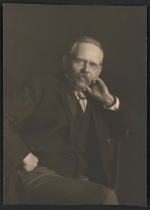
Biography:
Born in Denmark, Jacob Riis immigrated to American when he was twenty years old. Finding work was difficult in his time here, and Riis found himself passing through many states in the north east, such as Pennsylvania, New Jersey, and New York, in search of one. He would take whatever job came to him, which meant labor work and sales. He experienced homelessness as a first time immigrant in America. He finally got a job in NYC at a newspaper.
Now that he had a job, he won the hand of a woman he had been chasing after. He married Elisabeth Nielsen in 1876. The ceremony occurred in Denmark, where they are both from, and together they settled in New York to raise five children. They were married for 29 years before Elisabeth’s death in May 1905.
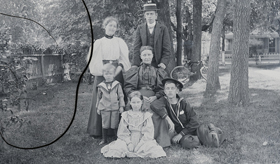
Riis kept a pocket diary to record his experiences during the high point of his struggle in life as an immigrant. They not only recount this section of struggle within his life, but also contain many entries of self-doubt. While this pocket diary recorded the more difficult points in his life, the last entry is written just after he asked Elisabeth to be his bride. The diary recorded the difficulties Riis encountered as an individual in America for the first time. With little to no money, and worries about where he would get his next day’s meal, it ends on a bright note when he finally wins the girl he had been struggling so hard for. He also wrote telegrams to his loved ones. One in particular, and pictured here, is Riis “[urging] their son John to hurry home to see his failing mother” (loc.gov).
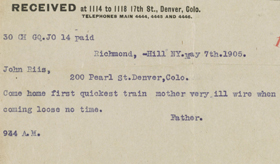
His autobiography, The Making of an American, details to his readers his experiences in such a degrading situation and position in society. It also shows his rise from such a degrading position to “a celebrated writer and confidant of the president of the United States” — Theodore Roosevelt (loc.gov).
~~~~~~~~~~~~~~~~~~~~~~~~~~~~~~~~~~~~~~~~~~~~~~~~~~~~~~~~~~~~~~~
Riis, having experiences in poverty himself, saw the necessity to help those in poor situations and marginalized locations of society. He used his skills as a photographer to bring these images to the middle class and show them the necessity of taking action.

Riis had a circle of reformers who were all concerned with the same thing: the living conditions of those who lived in the crowded slums of New York City. Together, they gathered data and advocated for many things to make the conditions of these individuals more humane. “They advocated for new housing designs to ease crowding and improve fire safety, sanitation, and access to air and light” (loc.gov). These were simple things that one would not think would have to be advocated for, but Riis saw that others were not stepping forward, so he decided to do it himself.
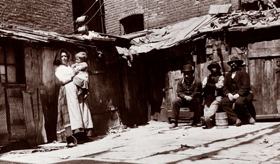
However, it was necessary as these individuals had been subjected to live in crowded, unsanitary, and often dark locations far away from the eye of the general public. Riis was always deeply concerned with the general health of the public. Riis developed a clever way of getting his concerns to be taken seriously by the elite in the city. He would discuss the issues in the slums, such as poor water quality, filth, pests, and horrible living conditions.

However, he would discuss these issues with the elite class in such a way that would show the wealthy residents that these conditions will not stay within the slums, but will instead leak out into the general population and effect everyone. For example, he would say that if the lack of sanitation in the slums was not resolved, it would result in a high outbreak of diseases such as typhus and cholera. Riis also used images of children working and living in filthy conditions, such as dumps. By using this images of the children, he was able to reach the population of mothers that would become greatly concerned with the conditions of poor mothers and their unfortunate children.
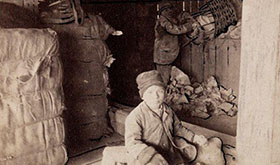
Riis left a legacy behind in his tireless work that he did during his lifetime. He brought the real concerns of the lower class to the public eye in ways that appealed to all levels society. He did not follow the general pattern of reformers of the time period, which included lobbying, rallying, and unionizing for change. But instead, he used his skills in journalism, photography, and the use of appealing to the public’s interest as ways to persuade individuals to believe in his causes. All that Riis did, and the ways in which he did them, “laid groundwork for what was to come” (loc.gov).
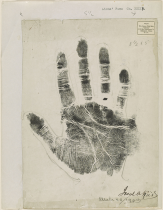
Riis Writes NYC:
“Downtown Back Alleys” is a chapter from Riis’ greater study, “How The Other Half Lives.” The link to buy the entire book is here: https://www.penguinrandomhouse.com/books/296501/how-the-other-half-lives-by-jacob-a-riis/9780140436792/
The link for the online chapter, “Downtown Back Alleys,” is here: https://www.bartleby.com/208/4.html
An Analysis of “Downtown Back Alleys”:
It is always interesting to learn about how the other half of the population lives, especially in a large city such as New York City. There will always be a sharp line drawn where the wealthy and the poor are separated. Their lives, mindset, and worries are drastically different. However, in the lower income population, there is this common theme of separation from all other individuals. Jacob Riis’s “Down Town Back-Alleys” speaks on this theme of loneliness and alienation individuals living in the city experience from not only the rest of America, but also between the individuals residing within it.
Riis’s was an immigrant himself and experienced much of what he writes on. He experienced homelessness and poverty during his lifetime when he arrived in New York City. He wrote this piece to study the slums and make the rest of the world know of the conditions and misery that can be found in these alleyways. There is this theme of both literal and figurative darkness that runs through his piece. The literal darkness would be that these alleys seem to be poorly lit, with very little natural and artificial lighting evident. There could possibly be very little electricity, or those living in the tenements cannot afford to pay their electric, so the homes and streets are dark when nighttime comes, as well. There is also this figurative darkness, especially concerning those blind individuals who lived in the alleyway in the beginning. This figurative darkness also speaks on this notion of loneliness and alienation those in the slums feels. They find themselves in this darkness, in this pit of despair, where all seems hopeless and lost. Riis tells the story of the mother at the wash basin, who states that she tries to keep the children and home clean, however as the narrator looks around, there is clothing hung up everywhere and the wash load does not seem to diminish.
The slums carry this repetitive lifestyle of those struggling to get by constantly, but at no point does their situation get better. Riis lived this life of misery and desperation himself. He felt the same loneliness and alienation from the rest of society like those experiencing it in that moment in the slums. He wrote this piece so that the rest of the world could feel it, too. Riis’s piece does not come with a happy ending, only a call to action. He has a deep desire for real change to occur so that those in the slums that live full and normal lives.
Bibliography:
Riis, et al. “Jacob Riis: Revealing ‘How the Other Half Lives’ Exhibition Home.” Jacob Riis: Revealing “How the Other Half Lives” | Exhibitions – Library of Congress, 14 Apr. 2016, www.loc.gov/exhibits/jacob-riis/index.html.
Riis, Jacob. “The Down Town Back-Alleys.” Writing New York: A Literary Anthology, edited by Phillip Lopate, Literary Classics of the United States, 2008, pp. 294-307.